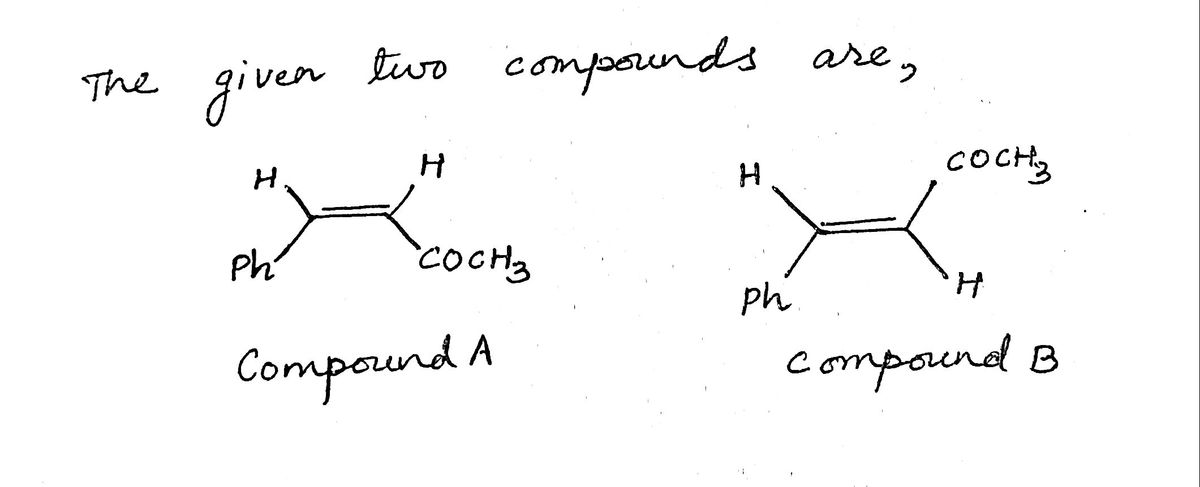Using proton NMR spectra, how could a chemist distinguish between the following two compounds? H. H. СОСН Ph COCH; Ph H. Compound A Compound B The alkene protons in compound A display a larger coupling constant. Compound A and compound B show a different number of signals in the proton spectrum. The alpha alkene proton would be more shifted than the beta alkene proton in compound B Proton NMR spectroscopy cannot be used to distinguish between these compounds. The alkene protons in compound B display a larger coupling constant.
Using proton NMR spectra, how could a chemist distinguish between the following two compounds? H. H. СОСН Ph COCH; Ph H. Compound A Compound B The alkene protons in compound A display a larger coupling constant. Compound A and compound B show a different number of signals in the proton spectrum. The alpha alkene proton would be more shifted than the beta alkene proton in compound B Proton NMR spectroscopy cannot be used to distinguish between these compounds. The alkene protons in compound B display a larger coupling constant.
Chemistry
10th Edition
ISBN:9781305957404
Author:Steven S. Zumdahl, Susan A. Zumdahl, Donald J. DeCoste
Publisher:Steven S. Zumdahl, Susan A. Zumdahl, Donald J. DeCoste
Chapter1: Chemical Foundations
Section: Chapter Questions
Problem 1RQ: Define and explain the differences between the following terms. a. law and theory b. theory and...
Related questions
Question
100%

Transcribed Image Text:Using proton NMR spectra, how could a chemist distinguish between the following
two compounds?
H.
H.
СОСН
Ph
COCH;
Ph
H.
Compound A
Compound B
The alkene protons in compound A display a larger coupling constant.
Compound A and compound B show a different number of signals in the proton spectrum.
The alpha alkene proton would be more shifted than the beta alkene proton in compound B
Proton NMR spectroscopy cannot be used to distinguish between these compounds.
The alkene protons in compound B display a larger coupling constant.
Expert Solution
Step 1

Step by step
Solved in 2 steps with 2 images

Recommended textbooks for you

Chemistry
Chemistry
ISBN:
9781305957404
Author:
Steven S. Zumdahl, Susan A. Zumdahl, Donald J. DeCoste
Publisher:
Cengage Learning

Chemistry
Chemistry
ISBN:
9781259911156
Author:
Raymond Chang Dr., Jason Overby Professor
Publisher:
McGraw-Hill Education

Principles of Instrumental Analysis
Chemistry
ISBN:
9781305577213
Author:
Douglas A. Skoog, F. James Holler, Stanley R. Crouch
Publisher:
Cengage Learning

Chemistry
Chemistry
ISBN:
9781305957404
Author:
Steven S. Zumdahl, Susan A. Zumdahl, Donald J. DeCoste
Publisher:
Cengage Learning

Chemistry
Chemistry
ISBN:
9781259911156
Author:
Raymond Chang Dr., Jason Overby Professor
Publisher:
McGraw-Hill Education

Principles of Instrumental Analysis
Chemistry
ISBN:
9781305577213
Author:
Douglas A. Skoog, F. James Holler, Stanley R. Crouch
Publisher:
Cengage Learning

Organic Chemistry
Chemistry
ISBN:
9780078021558
Author:
Janice Gorzynski Smith Dr.
Publisher:
McGraw-Hill Education

Chemistry: Principles and Reactions
Chemistry
ISBN:
9781305079373
Author:
William L. Masterton, Cecile N. Hurley
Publisher:
Cengage Learning

Elementary Principles of Chemical Processes, Bind…
Chemistry
ISBN:
9781118431221
Author:
Richard M. Felder, Ronald W. Rousseau, Lisa G. Bullard
Publisher:
WILEY